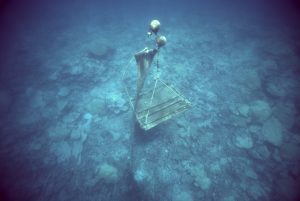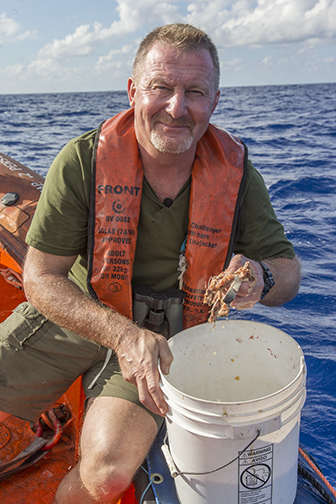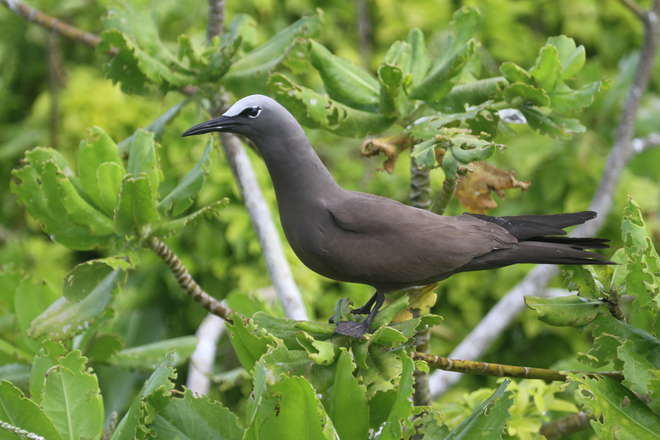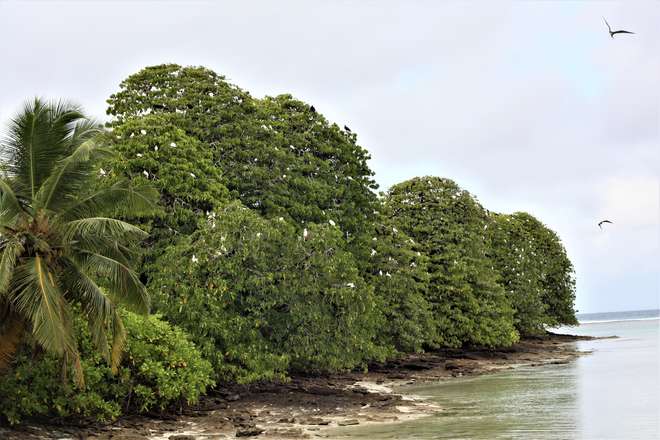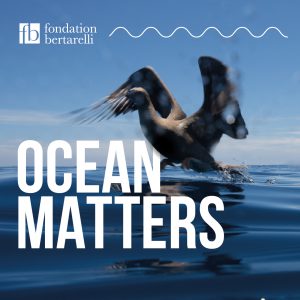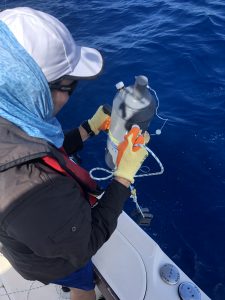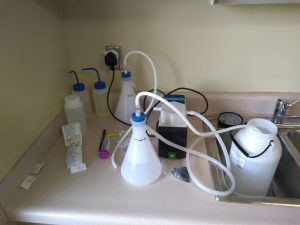Monitoring and identifying shark species in the Chagos Archipelago.
Recent work published by our researchers has shown that differences in movement strategies between two closely-related reef shark species can influence how vulnerable they are to poaching risk in the Chagos Archipelago and that by studying these movements, we can help to inform enforcement decisions in the MPA. Network analysis led by Dr David Jacoby, investigated the movement and space use of silvertip sharks (Carcharhinus albimarginatus) and grey reef sharks (Carcharhinus amblyrhynchos) around Peros Banhos and Salomon atolls in the Chagos Archipelago and showed that despite living side-by-side, the two species move through the MPA in very different ways. The study used acoustic tracking to study how individuals from these two shark species moved within the MPA. This method involves catching sharks, surgically implanting acoustic tags and setting up an array of underwater receivers which record the tag ID as a tagged shark swims past. From this, the researchers were able to highlight key movement corridors that MPA enforcement patrols can focus on to help protect the sharks from illegal, unregulated and unreported (IUU) fishing activity. This study also showed that silvertip sharks were more wide-ranging and therefore more vulnerable to IUU activity than grey reef sharks.
Another way to monitor species in the MPA is to use DNA. Genetic analysis can be used to identify the diversity of species in the territory and even explore whether there are distinct populations within species. One recent monitoring technique that is gaining attention in ecosystems all over the world is species detection using environmental DNA, also known as eDNA. As animals pass through their environment, they leave traces of DNA behind them. In the MPA surrounding the Chagos Archipelago, we can collect eDNA from the water and use it to determine what species are present and this is a great way to detect shark species that we otherwise might not see.
To achieve genetic monitoring and detection through eDNA, researchers must first know the genetic sequence of the species they want to study. To this end, researchers Nick Dunn (from ZSL and Imperial College London) and Shaili Johri (from Stanford University) have sequenced and published the mitochondrial genome sequences of the grey reef shark, silvertip shark, whitetip reef shark (Triaenodon obesus) and silky shark (Carcharhinus falciformis) from the Chagos Archipelago. Mitochondrial DNA is commonly used in genetic studies because it is easier to target than nuclear DNA and can be used to identify populations within species. To do this, small fin clips were taken from each of the species during tagging expeditions in the territory and their DNA was sequenced using two contrasting DNA sequencing techniques. Shaili used a handheld device called the Oxford Nanopore MinION to sequence whole mitochondrial genomes and Nick produced his sequences using a more conventional approach on an Illumina sequencer that involves breaking DNA into small fragments and reproducing the complete sequence by using overlapping fragments, a bit like a puzzle. The mitochondrial genome sequences produced were the first ever published for the grey reef shark and the silvertip shark, and a first from populations in the Chagos Archipelago for the whitetip reef shark and the silky shark.
The sequences produced from the two techniques were over 99% similar, showing that both methods can be used in future research as the few differences were most likely to be due to differences between the individuals sequenced rather than errors. These mitochondrial genome sequences will be used to produce eDNA detection protocols for the species, which will help researchers understand how eDNA can be used to monitor shark species in the MPA. The sequences and methods used can also be used to investigate the connectivity of sharks in the Indian Ocean and to determine how significantly Chagos Archipelago reef sharks contribute to the shark fin trade.
References
Dunn, N., Johri, S., Curnick, D., Carbone, C., Elizabeth, A., Chapple, T. K., et al. (2020) Complete mitochondrial genome of the gray reef shark , Carcharhinus amblyrhynchos ( Carcharhiniformes : Carcharhinidae ). Mitochondrial DNA Part B 5, 2080–2082. doi:10.1080/23802359.2020.1765208.
Jacoby, D. M. P., Ferretti, F., Freeman, R., Carlisle, A. B., Chapple, T. K., Curnick, D. J., et al. (2020) Shark movement strategies influence poaching risk and can guide enforcement decisions in a large, remote Marine Protected Area. J. Appl. Ecol. doi:10.1111/1365‐2664.13654.
Johri, S., Chapple, T. K., Dinsdale, E. A., Schallert, R., and Block, B. A. (2020a) Mitochondrial genome of the silky shark Carcharhinus falciformis from the British Indian Ocean Territory Marine Protected Area . Mitochondrial DNA Part B. doi:10.1080/23802359.2020.1775147.
Johri, S., Chapple, T. K., Schallert, R., Dinsdale, E. A., and Block, B. A. (2020b) Complete mitochondrial genome of the whitetip reef shark Triaenodon obesus from the British Indian Ocean Territory Marine Protected Area . Mitochondrial DNA Part B. doi:10.1080/23802359.2020.1775148.
Johri, S., Dunn, N., Chapple, T. K., Curnick, D., Savolainen, V., Dinsdale, E. A., et al. (2020c) Mitochondrial genome of the Silvertip shark, Carcharhinus albimarginatus, from the British Indian Ocean Territory. Mitochondrial DNA Part B Resour. doi:10.1080/23802359.2020.1765210.
News piece by Nick Dunn

